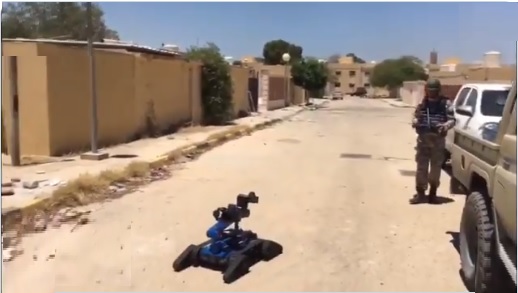
Turkey deploys homemade robots in Libyan battlefields
- ২১ জুলাই ২০২০, ০৫:২৫

After dominating the battlefields of Syria and Libya with frigates and drones, Turkish military advisers are now using robots in the Libyan conflict.
As Turkey’s advanced weapons technology makes a significant mark in regional conflicts, its latest addition of homemade drones is once again changing the military equation in Libya and creating an effective deterrence against the Assad regime in Syria.
The domestically produced TMR 2 (Kutlu), which has recently joined Turkey’s military inventory, is now helping to safely detonate explosives across Tripoli, the Libyan capital.
“Since the mid-2010s, Turkey has used its homemade robots in its military and police operations to deal with improvised explosive devices (IEDs). We are now using these robots in Libya, Syria and other places, where our soldiers have a military presence,” said a Turkish defense source, who wished to remain anonymous.
On Sunday, the Turkish Defense Ministry tweeted on how the robots have been in use in Tripoli.
“Our indigenous robot TMR II (Kutlu), which enables remote control and safe intervention, is effectively being used by our Explosive Ordnance Disposal (EOD) teams in Libya’s Tripoli during the operations of the detonation of IEDs and ammunition,” said the Defense Ministry’s tweet.
Turkey supports the UN-recognised Tripoli government against warlord Khalifa Haftar's militias in the Libyan conflict, deploying its military technology and experts in the country.
Haftar's militias have placed many explosives across the capital during their months-long siege of the capital as they invaded parts of Tripoli.
After the Turkish-backed Government of National Accord (GNA) forces kicked out Haftar's militias, Turkish robots are now on a mission of cleaning mines and other explosives from the city’s suburbs previously controlled by the warlord.
With the beginning of urban warfare in Libya, Turkey has begun deploying its robots in Tripoli to prevent unnecessary casualties, the source told TRT World.
“These small robots with high mobility deployed by cameras could enter any place in office buildings or homes even under difficult conditions, helping our military experts to detonate IEDs and other explosives,” the source explained.
Turkey’s military intervention has changed the political equation in Libya as Haftar's militias backed by Russia, the UAE and Saudi Arabia have begun losing critical territory across the western part of the country.
Turkey’s native robot industry
The TMR II has been developed by Elektroland Defence, a Turkish company based in Ankara’s Golbasi district, whose various robots have been used by different units of the country’s security forces including the army and the police.
The TMR-II bomb-dismantling robot has up to three hours of operation time, 500 metres of wireless control area, the ability to go up ramps of up to 45 degrees, cross 20 cm tall barriers, 35 cm moat crossing and climbing stairs
Turkey’s defense industry has also produced other robots like TMR-II Cetin, TMR-I Dincer and Kaplan Explosive Ordnance Disposal (EOD).
Among others, the Kaplan EOD, which is produced by Aselsan, one of Turkey’s leading military technology companies, is one of the most highly developed devices with its strength, endurance and user friendly interface.
“KAPLAN EOD enables the bomb squads to examine a suspicious object from at least 500 meters and is equipped with a seven-degree-of-freedom robotic arm for detailed inspection and disposal of explosives. The agile vehicle platform provides enhanced mobility on various terrains such as rock piles, steep slopes, stairs etc under snowy and muddy conditions,” informed the company about the robot’s capabilities on its official website.
“The onboard surveillance system enables the robot operator to examine suspicious objects with high resolution in real-time from the remote Operator Control Unit (OCU) and record for future examination,” it explained.
“Additionally, with 3D Robot display shown on the OCU, all movements of the robot can be monitored even if the robot is not within line of sight.”
Besides robots, the Turkish Navy’s frigates – most of which have also been produced domestically, making the country's navy among the world’s 10 strongest – have also played a prominent role in helping Tripoli recover from its losses. [Source: TRT World].